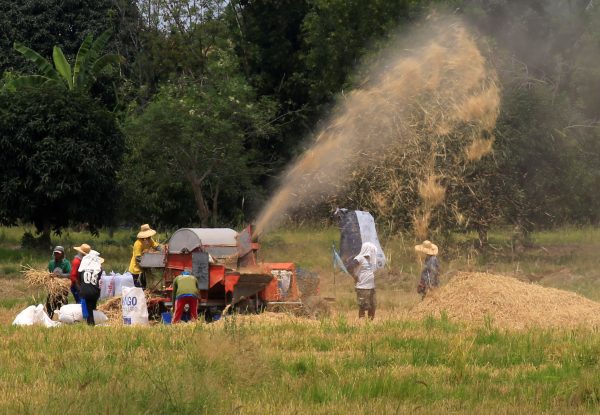Land reform was initially instituted as a developmental program involving mainly the distribution of public lands. But by the early 1970s, it became a strategy to jump-start agriculture productivity by dismantling the hacienda estate system and eliminating inefficient tenancy arrangements in the Philippine agriculture sector. The program then shifted to a redistributive welfare scheme that was compulsory and implemented nationwide for both publicly and privately held land used for agricultural purposes.
Over time, land reform has lost its political appeal. The budget for land acquisition and distribution has diminished from 0.44 per cent of GDP in 1988–1991 to 0.15 per cent of GDP for 2010–2016. At the turn of the 21st century, Congress had started to cut the budget for land acquisition and distribution. It gave low priority to the acquisition of new private land and directed the Department of Agrarian Reform to focus on support services for the more than 2.8 million land reform beneficiaries.
The current administration is also facilitating the use of agricultural land for non-agriculture purposes. The Department of Agrarian Reform’s first Administrative Order of 2019 simplified this process of land conversion by doing away with necessary productivity and land use clearances from the Department of Agriculture and the Housing and Land Use Regulatory Board.
A major accomplishment of the land reform program is the abolition of the hacienda estate system in all but the sugar-producing province of Negros Occidental. The more than 40 years of redistributive land reform placed roughly 83 per cent of total agricultural land in the country under the reform program. Average farm size has been reduced to 1.29 hectares — less than half the 1980 average of 2.84 hectares. Of the total 5.56 million farms in 2012, about 57 per cent are less than one hectare and only 0.03 per cent are farms with an area of 50 hectares and over.
On the other hand, the agriculture sector remains uncompetitive. Small farms are failing to move out of subsistence agriculture and into agribusiness. Land reform is partly to blame as the protracted and poor implementation of the program is moving the agriculture sector backwards. Agricultural land property rights have been complicated by legal restrictions on the transferability of land-reform awarded lands, a multiplicity of owners or rights to land, and errors in land reform coverage and beneficiary identification. These issues complicate land transactions and hinder investment into the sector.
Unfortunately, the government continues to ignore the warnings signs and is addressing the issue by intensifying controls on transfers of ownership, lease arrangements and on other contracts entered into by agrarian reform beneficiaries.
With globalisation and the onset of the Fourth Industrial Revolution, land reform as a redistributive strategy has become obsolete. In recent years, the routes to poverty alleviation in rural areas have increased. Impact studies also note that new ownership of land through land reform programs as a means to improve welfare is complicated. Labour statistics also show a declining share of agriculture in the labour force. Increasingly, the younger generations of farming households are better educated and equipping themselves with skills that are needed in either industry or the services sectors.
There is no way forward but to enable small farms to leapfrog into industrial agriculture systems.
One way is for the government to support land consolidation schemes such as block farming. Block farming is a land consolidation concept that allows farmers to individually manage farms under consolidated operations. This can bring about economies of scale for crops that require significant inputs and mechanisation. Block farming has been shown to reduce production costs, increase farm productivity and incomes, and enable farmers to establish agribusiness activities.
Land consolidation can also be done through joint farming. This involves land exchanges and sale to improve efficiency of agricultural land production. In countries that practice joint farming, government issued preferential policies on land transfers and transactions allow for temporary land acquisition, land renovation, and repurchase or lease of land tenures by the original owners.
Another strategy to enable agribusiness is contract farming. Contract farming provides small farmers with access to technology, technical guidance, financing and new markets through partnerships with global firms. With higher and better quality production, linking agriculture to domestic and global manufacturing and industry systems becomes easier.
Whichever path forward Philippine policymakers choose, the government has to provide the infrastructure and the legal and policy environment for these arrangements to flourish.
Dr. Marife M. Ballesteros is Vice President of the Philippine Institute for Development Studies (PIDS).


I have always commented that the beneficiaries of land reform (marginal farmers) may not be the correct choice. From being laborers, the govt can not expect them to suddenly own and cultivate their lands, and deal with the market forces for their products. Their education is mostly inadequate, as even professionals (salaried) often runs out of cash and had to tighten their belts days before their salary come. What more, for the farmers. A lot can be said in this regard.
Hence, I suggested that professionals, college graduates who have no land, but are wanting to pursue agriculture should be one of the prime considerations as beneficiaries. I even think that this potential group has few members, as those who are pursuing agriculture is dwindling in numbers. My own research showed this. We see around so much idle land. Govt effort is not sufficient, but can go a long way — provided there are good and capable farmers.
Hence, schools and even parents should encourage the pursuit of agriculture.